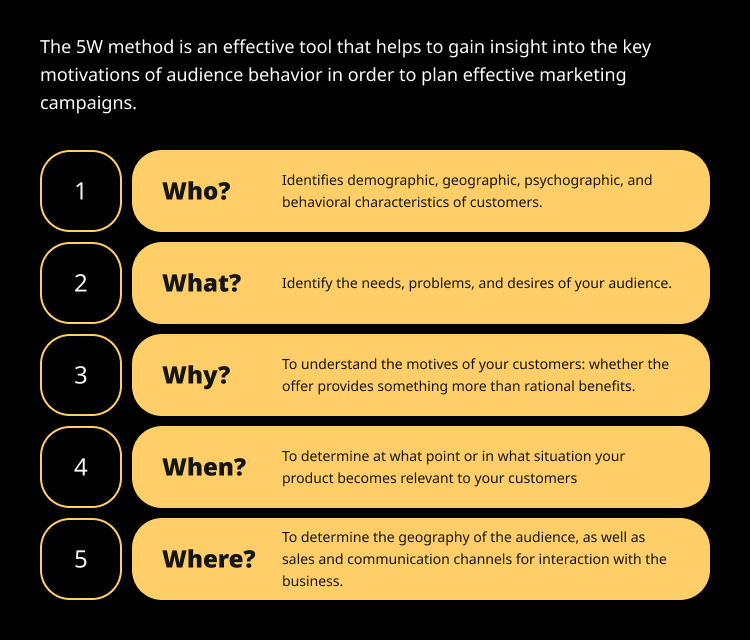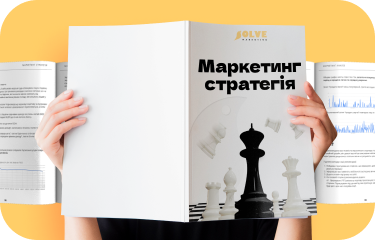Parents dream of a camp that will make their child braver, smarter, and more independent. A child wants a place where there will be a drive, a TV series-like atmosphere, new friends and complete freedom from boring leisure.
Krokers Camp is a club-format children’s camp that creates a unique environment for development, communication and active recreation with an individual approach to each child.
When the Krokers team came to Solve Marketing, they had the following experience:
- 15 years of experience at Petros Camp;
- a cool idea for a new product;
- a team that really lives for it.
Objective:
- Sell the *necessary* number of vouchers.
- Build marketing that will allow us to work not only in summer.
- To take the brand out of the Petros parentage and give it its own identity.
With such an ambitious goal, we needed a strategic approach that combines analytics, branding, lead generation, and preparation for scaling up for the sales season.
| How long did it take to develop the strategy? | 150 hours, 6 working weeks |
| What is the composition of the marketing strategy development team? | Head of Marketing Team, Head of PM Team, Head of Content Team, operational marketer, content marketer, head of PPC, Facebook PPC, editor. |
| How was the result of the work used? | Independent implementation by the client’s specialists. |
Project goals and challenges
Marketing works when there is a clear goal and an understanding of the context.
In the case of Krokers Camp, the task was as follows:
Sell the *necessary* number of vouchers
But in reality, there was a deeper transformation behind it:
- To launch a new brand that had previously existed only as part of another camp (Petros Camp).
- To build our own marketing system from scratch: from positioning to analytics.
- Build awareness in a market where there are already strong players – WestCamp, Life Camp, Fayno.
- To move away from the format of “one summer campaign” and lay the foundation for year-round operation.
Package the camp to speak to two different audiences at the same time:
➤ Parents (who make the decisions).
➤ Teenagers (who influence the choices).
Krokers needed a clear, structured strategy based on a deep understanding of parental and child choices.
Project analysis
A successful strategy starts with an audit of the current situation. We immersed ourselves in the project: social media, Google presence, existing lead generation – and investigated the relevance of the product. Because real development is about answering questions: “”What is currently hindering scaling?””
1. Social media: being present ≠ being understood
Even if you are active on social media, it does not mean that it will bring results: sales, recognition, trust. Both Petros and Krokers have profiles on Instagram, Facebook, and TikTok. But:
- If the content is duplicated without adaptation, instead of omnichannel reach, you can get low reach and low audience engagement.
- Instagram does not have a header with positioning, highlights with answers to parents’ queries, which means that the chance to build trust is lost.
- TikTok with trends without a brand identity. The videos get views, but they also don’t build trust because there is no clear message: “this is a children’s camp”.
- Krokers Camp is a “young” brand on social media with negative comments without a response. Of course, every business has negative reviews and comments. But communication with such customers is a signal to parents that the company is ready to engage in dialogue.
2. Google presence: silence in the age of search
While Petros Camp is building a reputation on Google Maps (4.6 out of 5 rating and active communication with customers), Krokers Camp is not there at all.
Insight: Google reviews = the new currency of trust. Even if you run an online business, reviews now have a priority impact on customer trust. That’s why a separate Google profile with a feedback collection system is a must-have for live sales.
3. Lead generation
We studied the advertising of both camps. Videos, emotions, beautiful visuals — everything is there. But there is a lack of audience segmentation. If a company launches ads directly on the messenger, it works only for warm, interested customers.
Insight: in 2025, advertising is the basic minimum, so in order to communicate with a cold audience, there should be clearly formed communication and elementary steps for purchasing. For example: divide campaigns into “new” and “repeat” customers and adapt the message to each.
4. Website: how to build a separate brand on the basis of another
Krokers Camp doesn’t have its own website, they are posted on the Petros Camp page. But Krokers is a separate concept, a different approach, a different energy.
This placement:
— devalues the uniqueness of the new product;
— creates a false impression of the camp concept, which reduces the clarity of positioning and creates barriers to communication with parents;
— reduces flexibility in launching marketing activities.
Insight: Launching a new brand requires a separate space for communication, both visually and in terms of content. Even a basic, but structured landing page is the foundation for forming an independent brand identity, testing hypotheses, and further scaling. That is why we recommended that Krokers Camp develop a separate platform with a well-thought-out tone of voice, targeted CTAs, and lead generation elements.
5. Internal analytics
Google Analytics was not set up, and the data from Similarweb showed that the session time was 22 seconds. This is a marker of loss of interest at the entrance. And without full-fledged analytics, it is impossible to understand what exactly is not working.
We have offered a whole set of technical solutions:
- GA4 integration
- verification of traffic sources;
- placement of UTM tags for campaigns;
- development of the website structure based on the real user experience (UX-audit).
Marketing of a single product requires:
- a clear brand architecture
- a comprehensive digital presence;
- elaborated selection factors integrated into every step of communication and interaction with the brand.
It is advisable to entrust the audit of current marketing processes to external experts in order to objectively assess the situation, identify areas of loss and missed opportunities that often go unnoticed from within.
We conduct an in-depth audit and develop a strategic action plan: from correction to scale, taking into account your business model, resources and goals – sign up for a free consultation.
Audience analysis
Audience segmentation is a key stage that allows us to clearly identify the needs and motivations of different consumer groups. We use the 5W method (Who, What, Where, When, Why) as a segmentation tool, as it provides a comprehensive approach to analysing the target audience and allows us to adapt the product to real market expectations.

This approach allows you to:
- create relevant messages for each group;
- build personalised promotion channels;
- increase conversion through an accurate understanding of customer motivation.
Do you want to research your audience so clearly that every message is “in the bull’s eye”? Sign up for a consultation — we’ll show you how segmentation turns into real-world applications.
Competitor analysis
In the context of developing a marketing strategy for Krokers Camp, we conducted in-depth competitive research. The research included a comparison of price offers and programmes, analysis of positioning strategies, digital activity, service quality and communication models.
Together with the client, we selected key competitors, and our experts conducted an audit of the competitive field with different focuses:
- Content marketer analyses the tone of voice, visual identity, logic of content creation and compliance of communications with the expectations of the target audience;
- a marketer with a focus on promotion and analytics evaluates pricing policy, offer structure, marketing tools, quality of lead generation, SEO visibility and channel efficiency.
This approach allows us to form comprehensive conclusions that take into account both external brand communication and the actual processes of customer acquisition and retention.
The competitive environment in the children’s camps sector in Ukraine is characterised by high saturation and diversity of models. However, this diversity opens up broad opportunities for strategic differentiation, in particular
- through unique positioning
- systematic pricing policy;
- focus on service;
- digital transformation;
- development of partner channels.
Our analytical model allows us to identify competitive practices and translate them into clear solutions to build systemic growth.
Mystery shopping
Digital presence analysis is just the tip of the iceberg. It shows what the company looks like online, but does not reveal how the customer sees the business.
To find out more, our marketers conducted a full-fledged study in the format of a “mystery shopper”: they followed the path of a real customer, analysed the experience of interacting with other camps, recorded entry points, strong triggers, and reasons for distrust.
What we did:
- We applied and contacted managers of competing camps.
- We collected call scripts, typical welcome messages, offers and presentations.
- We studied the triggers used by competitors to attract parents’ interest, and the visual and emotional elements included in communication.
- We assessed the humanity, speed, and information content of the responses.
This analysis became the basis for creating new communication funnels, first contact scripts, email templates, and presentations that are readable on a level of trust.
Not sure who your competitors are and how you stand out? Sign up for a free consultation. We will analyse the market and highlight your strengths.
SWOT analysis
Customer choice is always a multi-factor equation. Our task is to influence each of its components.
We often hear people say:
“We just feel that our product is unique and special. “21 And that’s great. But a feeling is a good place to start, not a solution.
Every brand has strengths that it sometimes doesn’t even realise, and weaknesses that hinder growth, even if they are carefully disguised.
That is why we conduct a SWOT analysis. For Krokers Camp, we assessed the entire context: internal strengths, weaknesses, external risks and windows of opportunity.
The SWOT analysis gave us an objective picture:
- Where are the strengths?
- Where are the risks?
- How do we win?
- How do we get elected?
You need a strategic approach to achieve your goals in a predictable way!
Choice factors
Most decisions — “yes” or “no” — are made based on the totality of everything that the customer sees and interacts with.
The customer forms a decision based on dozens of signals: the website, visuals, tone of communication, promises, guarantees, and the friendliness of the manager’s communication in the messenger — all of this together makes up the architecture of trust.
We have developed our own framework of choice factors that turns these signals into a manageable marketing tool. In the Krokers Camp project, we identified more than 100 factors that influence the choices of parents and teenagers, from CTA design to family communication scripts.
The choice factors framework is a strategic tool that allows you to influence the depth of a customer’s decision.
This approach helps to:
- Turn parents’ emotional expectations into rational arguments.
- Build trust through clearly defined processes.
- Take your brand to a new level of perception — without a radical rebrand.
To learn more about the Choice Factors Framework and how it can help your business, follow this link.
Positioning
Positioning is a strategic tool that determines where your brand stands in the minds of your target audience relative to your competitors. It is not just a slogan or a phrase in the header of the website — it is the basis of the entire marketing system.
Correctly formulated positioning ensures consistency in communication, a clear brand image, and sets clear expectations for customers.
The work on positioning does not end on the pages of the document. In order for it to work as a growth tool, it needs to be implemented at all key points of contact with the audience:
- website and landing pages
- presentation materials;
- social networks;
- sales scripts and internal team regulations.
💡Insight: The right positioning allows you to attract a loyal audience even in highly competitive niches.
This is possible only if the team fully shares the formulated idea. That’s why the final version of the positioning should not only be professionally sound, but also internally accepted.
When developing the positioning for Krokers Camp, we based our decision on
- marketing brief;
- analysis of competitors’ positions;
- study of customer choice factors;
- analysing the values, philosophy and real advantages of Krokers Camp.
After that, we gave the client several options for working positioning concepts.
Want to check whether your positioning really works for sales or just “exists”? Sign up for a free consultation and we’ll discuss the next steps.
Lead generation and SMM strategy
At the start of our cooperation, we had a clear task: to form a stable flow of applications. This requires a comprehensive ecosystem of interaction with potential customers: from the first touch to the application.
Key actions for Google Ads and Meta Ads:
- We divided the audience by sales funnel.
- We studied the seasonality, risks, and feasibility of promotion.
- We conducted an audit of the existing advertising office.
- We took into account the seasonality: the demand peaks in May and June.
- We developed a step-by-step promotion and scaling strategy.
- We created a test media plan.
Stage 1: Advertising strategy on Google
We started with the lowest floor of the funnel — those who are already looking for a place to send their child to camp. Through search advertising, we targeted parents who had already entered key queries such as “summer camp for children”, “camp for teenagers”, etc. in Google. But at the same time, we didn’t stop at the “hot” audience. Through Performance Max, video ads on YouTube, and remarketing, we reached a wider audience — those who had not yet made a decision but were already interested in the topic.
Stage 2: Meta ads
At Meta, our approach was different: emotional, warm, and friendly. We knew that parents make decisions with their hearts. That’s why we focused on videos that convey the atmosphere of the camp — the happiness of the children, the scenery, creativity, hugs. Three waves of campaigns:
- Attracting attention — building awareness, getting to know the brand.
- “Warming up — reviews, tests, storytelling to get people interested and ready for the application.
- Conversions — lead forms with a minimum of fields, personalised offers, quiz funnels.
💡Insight: we realised that it is important to adapt offers to different segments: for those who value safety, we focused on medical support; for those who are looking for development, we created a programme with masters; for teenagers, we created videos with live stories.
Additionally, we researched competitors’ promotions: their creatives and texts, and created the architecture of the advertising office:

Stage 3: SMM
Instagram and TikTok have become a space of constant contact. We saw that in the off-season, the audience “will go cold”, so our task is to stay in the field of its attention.
What we advised:
- Expand the content plan — from behind-the-scenes videos to alumni stories.
- Update the visuals — highlights, corporate identity, interactives.
- Activate TikTok — videos with challenges, humour, children’s reactions.
- Add a segment for corporate clients — highlights, infographics, terms of cooperation.
We wrote a social media development strategy, where we showed references, an action plan, and outlined expected results and KPIs.
Conclusion
With properly tuned advertising campaigns, emotional content, and constant SMM support, we have built a sustainable lead generation system.
What’s next?
At the final stage of the work, we outline the main tools, steps and phasing required to achieve the goals in the form of a strategic backlog — a structured plan with more than 100 strategic and operational objectives covering all key areas of brand development.

This backlog allows the team to move forward in a focused manner, without wasting time on constant clarification of what to do next, and on the constant search for priorities. You get a real strategic development plan for the year with clear priorities, deadlines and responsibilities — from marketing and digital to communications and internal processes.
We work not as a contractor, but as a strategic partner
We immerse ourselves in your context and help you move towards your goals, taking into account the realities of your business.
No matter what stage you’re at:
— a startup looking to grow quickly;
— a stable business preparing to scale or launch a new product.
We will help you build a marketing system from the basics to the result:
👉 from visual style and positioning to brand trust;
👉 from content and communication to sales and repeat business;
👉 from the first customer touch to a predictable funnel and a stable system.
Do you want not just a strategy, but a step-by-step system of brand growth for a year? Sign up for a free consultation and we’ll show you what a strategic backlog looks like in action.




